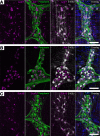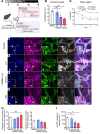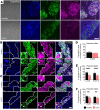LPAR1 regulates enteric nervous system function through glial signaling and contributes to chronic intestinal pseudo-obstruction
- PMID: 35166239
- PMCID: PMC8843750
- DOI: 10.1172/JCI149464
LPAR1 regulates enteric nervous system function through glial signaling and contributes to chronic intestinal pseudo-obstruction
Abstract
Gastrointestinal motility disorders involve alterations to the structure and/or function of the enteric nervous system (ENS) but the causal mechanisms remain unresolved in most cases. Homeostasis and disease in the ENS are processes that are regulated by enteric glia. Signaling mediated through type I lysophosphatidic acid receptors (LPAR1) has recently emerged as an important mechanism that contributes to disease, in part, through effects on peripheral glial survival and function. Enteric glia express LPAR1 but its role in ENS function and motility disorders is unknown. We used a combination of genetic, immunohistochemical, calcium imaging, and in vivo pharmacological approaches to investigate the role of LPAR1 in enteric glia. LPAR1 was enriched in enteric glia in mice and humans and LPA stimulated intracellular calcium responses in enteric glia, subsequently recruiting activity in a subpopulation of myenteric neurons. Blocking LPAR1 in vivo with AM966 attenuated gastrointestinal motility in mice and produced marked enteric neuro- and gliopathy. Samples from humans with chronic intestinal pseudo-obstruction (CIPO), a severe motility disorder, showed reduced glial LPAR1 expression in the colon and ileum. These data suggest that enteric glial LPAR1 signaling regulates gastrointestinal motility through enteric glia and could contribute to severe motility disorders in humans such as CIPO.
Keywords: Calcium signaling; G protein–coupled receptors; Gastroenterology; Homeostasis; Neuroscience.
Conflict of interest statement
Figures







Similar articles
-
Mini-review: Enteric glial cell reactions to inflammation and potential therapeutic implications for GI diseases, motility disorders, and abdominal pain.Neurosci Lett. 2023 Aug 24;812:137395. doi: 10.1016/j.neulet.2023.137395. Epub 2023 Jul 13. Neurosci Lett. 2023. PMID: 37451357 Free PMC article.
-
Cholinergic activation of enteric glia is a physiological mechanism that contributes to the regulation of gastrointestinal motility.Am J Physiol Gastrointest Liver Physiol. 2018 Oct 1;315(4):G473-G483. doi: 10.1152/ajpgi.00155.2018. Epub 2018 Jun 21. Am J Physiol Gastrointest Liver Physiol. 2018. PMID: 29927320 Free PMC article.
-
Functional Intraregional and Interregional Heterogeneity between Myenteric Glial Cells of the Colon and Duodenum in Mice.J Neurosci. 2022 Nov 16;42(46):8694-8708. doi: 10.1523/JNEUROSCI.2379-20.2022. Epub 2022 Nov 1. J Neurosci. 2022. PMID: 36319118 Free PMC article.
-
Novel understanding on genetic mechanisms of enteric neuropathies leading to severe gut dysmotility.Eur J Histochem. 2021 Nov 25;65(s1):3289. doi: 10.4081/ejh.2021.3289. Eur J Histochem. 2021. PMID: 34818877 Free PMC article. Review.
-
Enteric glial cells: new players in gastrointestinal motility?Lab Invest. 2007 Jul;87(7):628-32. doi: 10.1038/labinvest.3700564. Epub 2007 May 7. Lab Invest. 2007. PMID: 17483847 Review.
Cited by
-
Enteric glia promote visceral hypersensitivity during inflammation through intercellular signaling with gut nociceptors.Sci Signal. 2023 Nov 21;16(812):eadg1668. doi: 10.1126/scisignal.adg1668. Epub 2023 Nov 21. Sci Signal. 2023. PMID: 37988454 Free PMC article.
-
Stimulator of interferon genes (STING) expression in the enteric nervous system and contributions of glial STING in disease.Neurogastroenterol Motil. 2023 Jul;35(7):e14553. doi: 10.1111/nmo.14553. Epub 2023 Feb 27. Neurogastroenterol Motil. 2023. PMID: 37309618 Free PMC article.
-
Astrocyte Cell Surface Antigen 2 and Other Potential Cell Surface Markers of Enteric glia in the Mouse Colon.ASN Neuro. 2022 Jan-Dec;14:17590914221083203. doi: 10.1177/17590914221083203. ASN Neuro. 2022. PMID: 35593118 Free PMC article.
-
Idiopathic chronic intestinal pseudo-obstruction syndrome is strongly associated with low serum levels of vitamin D.Eur J Gastroenterol Hepatol. 2024 May 1;36(5):584-587. doi: 10.1097/MEG.0000000000002757. Epub 2024 Mar 25. Eur J Gastroenterol Hepatol. 2024. PMID: 38477850 Free PMC article.
-
Mini-review: Enteric glial cell reactions to inflammation and potential therapeutic implications for GI diseases, motility disorders, and abdominal pain.Neurosci Lett. 2023 Aug 24;812:137395. doi: 10.1016/j.neulet.2023.137395. Epub 2023 Jul 13. Neurosci Lett. 2023. PMID: 37451357 Free PMC article.
References
Publication types
MeSH terms
Substances
Grants and funding
LinkOut - more resources
Full Text Sources
Other Literature Sources
Molecular Biology Databases
Miscellaneous

